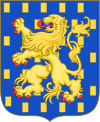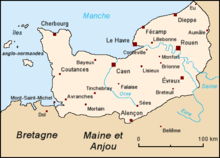Gilbert, Count of Brionne
Gilbert de Brionne 2nd Count of Eu 2nd Count of Brionne | |
|---|---|
| (Cognomen: Gilbert Crispin) | |
 Arms of the Counts of Eu from the House of Normandy: D'azur, au lion d'or,l'écu semé de billettes d'or | |
| Hereditary | |
| Count of Eu | 1015-1040 |
| Predecessor | Geoffery, 1st Count of Eu, 1st Count of Brionne |
| Successor | William II |
| Born | 1000 C.E. |
| Died | 1040 C.E. |
| Buried | Duchy of Normandy |
| Family | de Clare |
| Issue | Richard Fitz Gilbert Baldwin FitzGilbert |
| Father | Geoffrey, Count of Eu |
| Mother | Lasceline De Turqueville |
| Occupation | Norman Peerage |
Gilbert (or Giselbert) de Brionne, 2nd Count of Eu, 2nd Count of Brionne (c. 1000 – c. 1040), was an influential Norman Nobleman in the Duchy of Normandy in Northern France.[1][2] He was one of the early guardians of Duke William II in his minority.[1][3] If Lord Brionne would have survived his murder the senior house of de Clare would have probably been known as de Brionne.[1][3] Lord Brionne was the first to be known by the cognomen Crispin because of his hair style which stood up like the branches of a pine tree.[1][3]
Life
Gilbert de Brionne was son of Geoffrey de Brionne, Count of Eu (born 962) who was an illegitimate child of Richard I of Normandy.[4] He inherited Brionne, becoming one of the most powerful landowners in Normandy. Gilbert was a generous benefactor to Bec Abbey founded by his former knight Herluin in 1031. When Robert I died in 1035, his illegitimate son William inherited his father's title and several powerful nobles, including Gilbert of Brionne, Osbern the Seneschal and Alan of Brittany, became William's guardians.[1][3]
Death

A number of Norman barons including Ralph de Gacé would not accept an illegitimate son as their leader. In 1040 an attempt was made to kill William but the plot failed. Gilbert however was murdered while he was peaceably riding near Eschafour.[5] It is believed two of his killers were Ralph of Wacy and Robert de Vitot. This appears to have been an act of vengeance for the wrongs inflicted upon the orphan children of Giroie by Gilbert,[6] and it is not clear what Ralph de Gacé had to do in the business.[a] Fearing they might meet their father's fate, his sons Richard and his brother Baldwin were conveyed by their friends to the court of Baldwin V, Count of Flanders. His children would accompany Duke William on his conquest of England and his descendants would become one of the most powerful noble families in the British isles. They would rule over vast lands in modern day Ireland, Scotland, and England and become powerful Marcher Lords who acted independently of the crown.
Children
- Sir Richard Fitz Gilbert (Richard de Clare) (bef. 1035–c. 1090), m. Rohese Giffard (1034-aft. 1113), daughter of Walter Giffard, Lord of Longueville[7]
- Baldwin FitzGilbert (d. 1090)[4]
- William (-after 29 Aug 1060)
- Adela, m. Neel I, viscount of Cotentin (-Aug 1092)
Through these sons Gilbert was ancestor of the English house of de Clare, of the Barons FitzWalter, and the Earls of Gloucester (see Earl of Gloucester) and Hertford (see Earl of Hertford).
Notes
- ^ Although, Ralph de Gacé was the brother-in-law of Hawisa d'Échauffour, daughter of Giroie. See: Schwennicke, ES II, 79; ES III/4, 697.
External links
Further information on the life of Gilbert of Brionne and his place in the heart of Normandy's history - link to history blog
References
- ^ a b c d e Robinson, J. A. (1911). Gilbert Crispin, abbot of Westminster: a study of the abbey under Norman rule (No. 3). University Press.
- ^ Deck, S. (1954). Le comté d'Eu sous les ducs. In Annales de Normandie (Vol. 4, No. 2, pp. 99-116). Université de Caen.
- ^ a b c d Holt, J. C. (1997). Colonial England, 1066-1215. A&C Black.
- ^ a b George Edward Cokayne, The Complete Peerage of England Scotland Ireland Great Britain and the United Kingdom, Extant Extinct or Dormant, ed. Vicary Gibbs, Vol. IV (London: The St. Catherine Press, Ltd., 1916), p. 308
- ^ David C. Douglas, William the Conqueror (Berkeley & Los Angeles: University of California Press, 1964), p. 40
- ^ Ordericus Vitalis, The Ecclesiastical History of England and Normandy, trans. Thomas Forester, Vol. I (London: Henry G. Bohn, 1853), p. 391, n. 2
- ^ James Dixon Mackenzie, The castles of England: their story and structure, Vol.1, (The Macmillan Co., 1896), 47.
